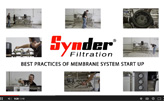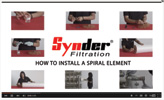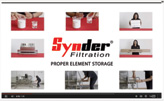FAQ
Categories
ELEMENTS/ADDITIONAL PRODUCTS
1. What is the average shelf life of Synder membranes?
Flat sheet membranes and spiral-wound elements, if stored correctly, have a typical shelf life of 6 to 12 months.
2. How can I determine if an element is compatible with a specific chemical?
Please follow this link to access our chemical compatibility tool. This tool allows users to input chemicals that may be found in their feed solution and determine the resistivity of the element to them. It is important to ensure that all materials used in element construction (permeate tube, membrane, ATD, etc.) are compatible with the chemicals within the feed solution.
If the chemical you are looking for is not listed, or if the concentration is higher than shown, please contact Synder Filtration directly for more information.
3. What is the difference between a sanitary element with and without a “tail”?
To further improve the fit of the element in the vessel, Synder Filtration offers a “trim-to-fit” outerwrap version. This is referred to as a “tail” option for sanitary elements only. Since the inner diameter can sometimes vary between vessels, this allows for a customized fit for each vessel.
4. Do you manufacture other products besides filtration elements?
Yes, we also specialize in manufacturing anode cells, which can be used in combination with our V-Series electrocoat UF elements for automotive paint processes. In addition, we have cleaning chemicals and pretreatment options to use along with our filtration elements.
5. Does Synder manufacture RO membranes?
Synder does not manufacture RO membranes. Currently, we manufacture nanofiltration, ultrafiltration, and microfiltration membranes, as well as anode cells and systems.
FEASIBILITY TESTING
1. I have a new application, but I’m not sure if I can use membranes for my process. Do you provide testing services to determine if membrane filtration is feasible for my application?
Why yes we do! Synder Filtration offers both feasibility testing services and pilot study program. Feasibility tests are done on-site at Synder HQ using either a flat sheet test loop or 2540 pilot system… READ MORE
Why yes we do! Synder Filtration offers both feasibility testing services and pilot study program. Feasibility tests are done on-site at Synder HQ using either a flat sheet test loop or 2540 pilot system. Flat sheet test loops are used for customers looking to determine which specific membrane provides the optimal flux and separation performance, as multiple membrane types can be tested simultaneously. 2540 pilot systems are useful for determine the pressure drop across an element, and provide additional data that can be used for scaling up to large-scale systems. Pilot systems are also available for rent on a monthly basis.
Additionally, we offer a membrane development program for customers looking to customize an element and/or work closely with us to create innovative membranes to suit their specialty process application.
STORAGE/INSTALLATION
1. How do I precondition flat sheet membranes prior to use?
1. Remove the new flat sheet from its storage bag and ensure that the flat sheet has not been damaged or tampered with. Look for any scratches, wrinkles, and/or deformities that could hinder performance… READ MORE
1. Remove the new flat sheet from its storage bag and ensure that the flat sheet has not been damaged or tampered with. Look for any scratches, wrinkles, and/or deformities that could hinder performance.
2. Carefully rinse the flat sheet with RO or DI water before usage. This will flush out any preservatives and other unwanted materials attached to the flat sheet.
3. Make sure your hands are clean before handling the flat sheet. Hold onto the ends of the flat sheet when transferring it around. Do not contaminate the membrane as much as possible as this may hinder performance.
4. Place the flat sheet onto the filtration cell body and secure tightly.
5. Increase the pressure in the system slowly until you reach your desired pressure level. It is important not to rapidly increase pressure as this may cause over compaction in the membrane.
6. Properly store the flat sheet when it is not in use. It is important that you do not allow the membrane to dry out at any point in time.
For the full set of Flat Sheet Membrane Installation & Storage Guidelines, download the PDF here.
2. How do I store my elements after use?
A. 6 MONTHS OR LESS (SHORT TERM)
Immediately following the final CIP flush, the system should be filled with 1% Sodium Metabisulfite (MBS) solution with a pH of 4.0-5.0. Every 7-10 days the following procedure should be performed… READ MORE
A. 6 MONTHS OR LESS (SHORT TERM)
Immediately following the final CIP flush, the system should be filled with 1% Sodium Metabisulfite (MBS) solution with a pH of 4.0-5.0. Every 7-10 days the following procedure should be performed:
1. Drain MBS solution from the system and flush to drain with clean water.
2. Run a caustic wash. (See caustic wash directions on p. 17 and 18)
3. Flush to drain with clean water.
4. Recharge the system with a fresh bath of MBS.
B. LONGER THAN 6 MONTHS (LONG TERM)
A long term shutdown (over 6 months) can be handled easily and efficiently. This involves the removal of elements from the system, soaking them in preservative solution (vertically if possible), and sealing in a plastic bag for future use.
1. The preservative solution should include:
■ 20% Glycerine
■ 2% Sodium Metabisulfite
■ pH 4.0-5.0
2. Remove the element from the vessel, drain the elements in a vertical position to avoid extensive dilution of the preservative solution.
3. Place the element in a preservative for a minimum of 15 minutes.
4. Remove the element from the preservative and allow it to drain for approximately 10 seconds, then place the element back in the bag.
5. Seal the bag either via heat seal or waterproof tape. This should be done well to prevent any leakage during storage/ transport.
6. Depending on the number of elements, the preservative solution may become diluted. In that event, add more preservative to maintain pH 4.0-5.0.
7. Element storage in 50°F – 59°F (10°C – 15°C) will increase storage life of the elements. If refrigeration is possible, it is highly recommended by Synder Filtration.
8. Contact Synder Filtration prior to storing ANY elements to discuss any remaining element warranty.
Also add link to download full PDF (Element Storage Procedure)
3. How do I properly install a spiral-wound element?
Depending on the element type (sanitary or industrial), we offer two different sets of guidelines for correctly installing our spiral-wound elements. These are included in each order, but can also be downloaded below or found on our website under Resources… READ MORE
Depending on the element type (sanitary or industrial), we offer two different sets of guidelines for correctly installing our spiral-wound elements. These are included in each order, but can also be downloaded below or found on our website under Resources.
Sanitary Element Installation Guideline PDF
Industrial Element Installation Guideline PDF
We also have a tutorial showing how to install sanitary elements. This video explains the difference in element installation for sanitary elements with and without a “tail” polypropylene mesh outerwrap.
PROCESSING CAPABILITIES
1. What happens if the element is pushed beyond the inlet pressure, or pressure drop limits?
Membrane integrity can be compromised if the element is pushed beyond recommended operational limits. Operating the elements beyond the maximum inlet pressure and pressure drop may cause telescoping to occur… READ MORE
Membrane integrity can be compromised if the element is pushed beyond recommended operational limits. Operating the elements beyond the maximum inlet pressure and pressure drop may cause telescoping to occur and can potentially delaminate the membrane itself, compromising the mechanical strength of the element. Having a high inlet pressure in a vessel with multiple elements in series will cause lead elements to have excessively high flux and tail elements to have extremely low flux, leading to an increase in pressure drop across the elements. Examples of visible damage include cracks in the endcap, feed spacer net protruding from the concentrate channels, breaking of the fiberglass shell outerwrap, etc.
The maximum recommended pressure drop per element is 15 psi (103 kPa), with a maximum pressure drop of 60psi (414 kPa) per housing. The maximum inlet pressure for UF and MF elements is 120psi, while the maximum inlet pressure for NF elements is 600psi.
2. What are the maximum total solids that a spiral element can handle?
Synder currently offers diamond feed spacers ranging in thickness from 31 to 80mil and ribbed spacers available in 46mil and 80mil thicknesses. The following chart shows the total solids limits for dairy products based on feed spacer type.
| Dairy Product Total Solids Limits |
Spacer |
| Products |
31mil |
46mil |
65mil |
80mil |
| Sweet Whey Max. T.S. |
15 |
25 |
28 |
30 |
| Acid Whey Max. T.S. |
15 |
24 |
26 |
28 |
| Skim Milk Max T.S. |
14 |
24 |
26 |
28 |
| Whole Milk Max T.S. |
15 |
30 |
33 |
35 |
*Note: Trials should be made to determine temperature and viscosity effects.
3. What’s the difference in performance v. cost of polymeric v. ceramic membranes?
| Module Type |
Advantages |
Disadvantages |
| Spiral-Wound Polymeric Membranes |
-Low cost less per square meter
-Less energy to operate
-Small footprint
-Robust designs to prevent membrane breakage
-Low capital/operating costs |
-Must reduce TSS to a minimum to prevent plugging of membrane
-Moderate product life |
| Ceramic Membranes |
-Tighter pore size distributions
-More consistent pore sizes
-Long product life
-Able to handle aggressive temperature and pH conditions |
-High capital/operating costs
-Large footprint |
WARRANTY
1. How does Synder handle warranty claims, and what is covered under warranty?
Synder Filtration guarantees all of spiral-wound membrane elements to be free from defects in design, materials or workmanship for a period of 12 months from date of installation or 18 months from date of shipment…READ MORE
Synder Filtration guarantees all of spiral-wound membrane elements to be free from defects in design, materials or workmanship for a period of 12 months from date of installation or 18 months from date of shipment, whichever comes first, provided that no equipment malfunction, operational error, cleaning regimen error or negligence is responsible for element failure. Any written instructions that may be provided by Synder Filtration must be followed.
A membrane element covered under this guarantee will be replaced free of charge, F.O.B. Vacaville, California, for the first 90 days (from date of shipment). During the remaining warranty period of 275 days, failed element replacement will be on a prorated basis, F.O.B. Vacaville, California. The prorated value will be calculated as such: (Unit price of the element) X (number of days elapsed since startup/365 days).
For a copy of the complete element warranty policy, please email your sales representative or sales@synderfiltration.com.
NEW PRODUCTS
1. How can I stay updated on recent news and product announcements?
New Products can be found within the Products section of our website. Besides the announcements made through our website, we also keep all four of our social media platforms up-to-date with all our latest news. Click below and follow our pages to stay updated on company and membrane filtration related news!















